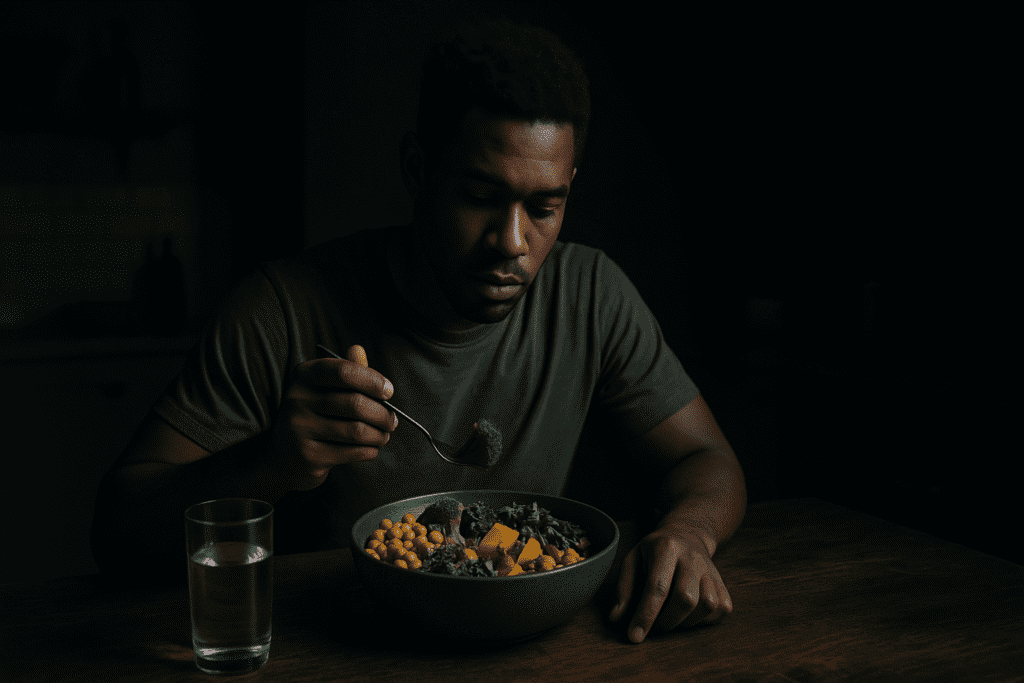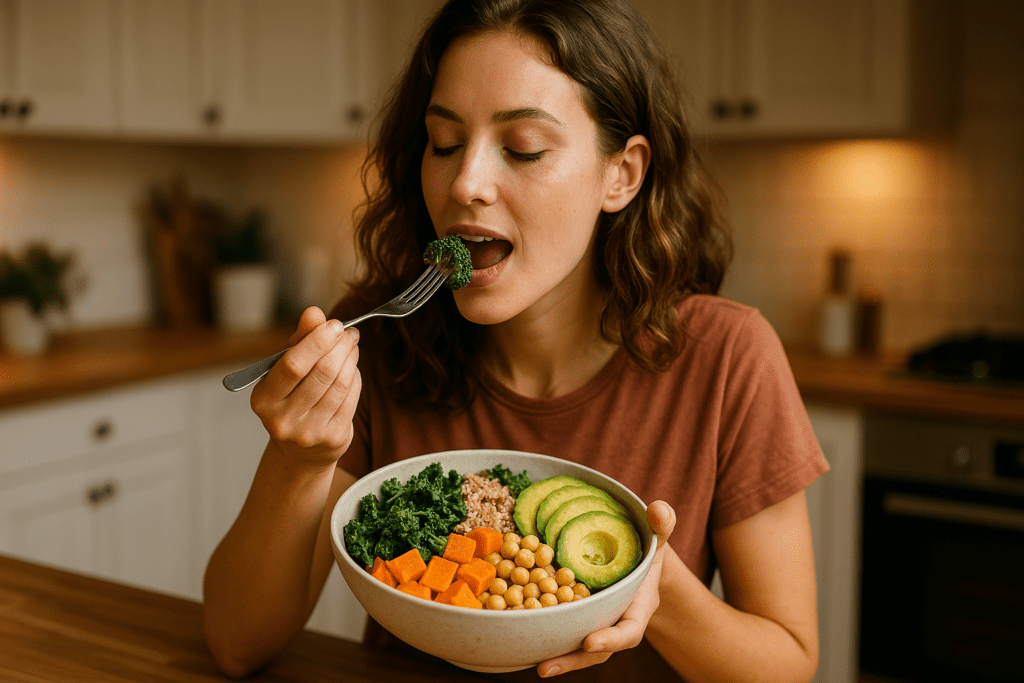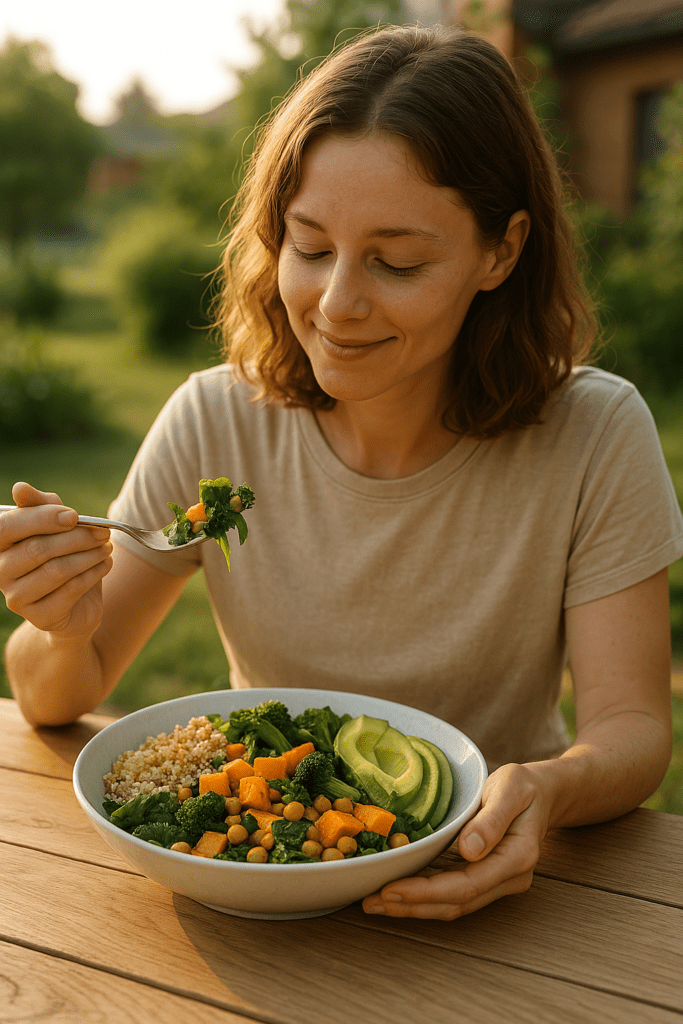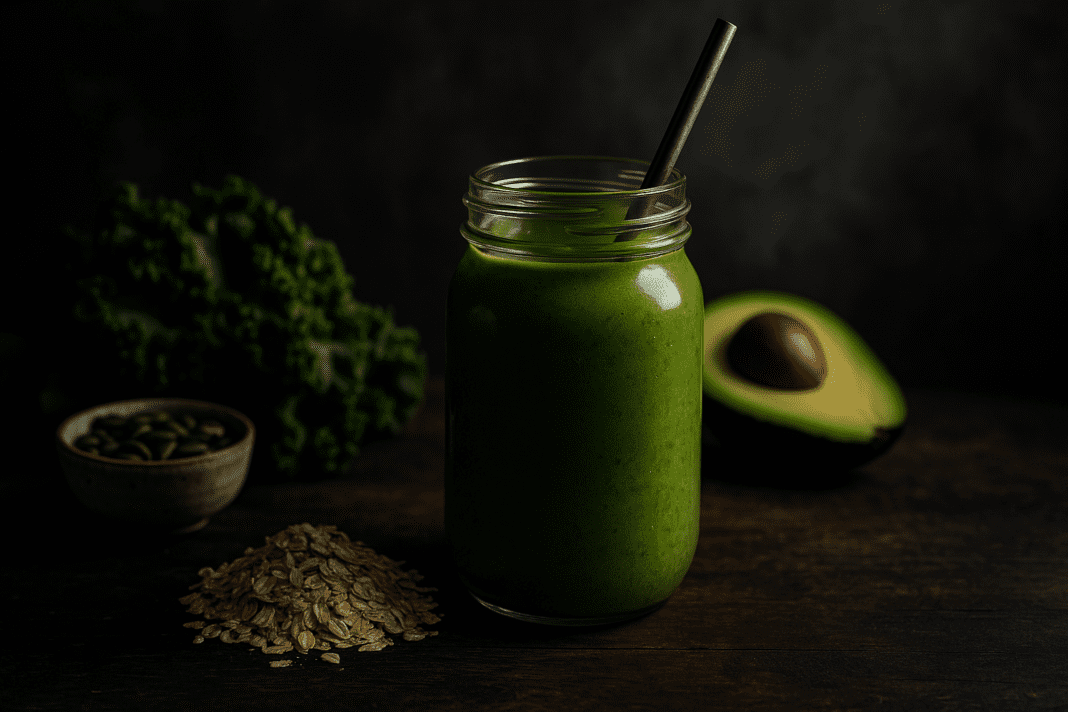Adopting a vegan lifestyle is a personal and transformative choice, often driven by health, environmental, and ethical considerations. But for many, the question lingers: what can a vegan eat? At first glance, eliminating animal products may seem restrictive, but the reality is that vegan cuisine opens the door to an expansive, flavorful, and nutritionally rich world of food. From vibrant vegetables and hearty legumes to inventive meat alternatives and international dishes, healthy vegan eating offers a remarkable range of possibilities.
You may also like: Healthy Plant-Based Dinners Made Easy: Best Whole Food Plant-Based Recipes for Beginners and Beyond
Understanding what does a vegan person eat involves looking beyond simple labels. Veganism isn’t about what is left off the plate but about what is thoughtfully included. Nutrient-dense, plant-based whole foods form the cornerstone of this dietary approach, and they support both short-term vitality and long-term wellness. Whether you’re just starting your journey or refining your habits, discovering practical vegan meal ideas and healthy vegan recipes can help transform your routine and optimize your health.
The Fundamentals of a Vegan Diet: What Does a Vegan Eat?
At its core, a vegan diet consists of all foods that are derived from plants. This includes fruits, vegetables, grains, legumes, nuts, and seeds. To maintain a healthy vegan lifestyle, it is essential to emphasize whole, minimally processed foods, and to create a balance that provides all necessary macronutrients and micronutrients.
People often ask what foods do vegans eat on a daily basis. The answer varies widely based on personal preference, cultural influences, and nutritional needs. However, most vegan diets revolve around a few key staples: leafy greens such as kale and spinach, protein-rich legumes like lentils and chickpeas, whole grains including brown rice and quinoa, and healthy fats from sources such as avocados, nuts, and olive oil. These ingredients serve as the building blocks for a vast array of meals, ranging from salads and soups to stir-fries and stews.
For anyone asking, what does a vegan diet consist of? Or, more specifically, what can a vegan eat list of foods? The options are both diverse and satisfying. Whole grains like oats, barley, and millet provide fiber and slow-burning energy. Beans, lentils, and tofu contribute protein and iron. Cruciferous vegetables offer important phytonutrients and antioxidants. Meanwhile, a colorful variety of fruits helps ensure a full spectrum of vitamins and minerals. Knowing what do vegan people eat is about recognizing that a plant-based lifestyle does not mean deprivation but abundance.
Dispelling the Myths: What Vegans Can Eat vs. What They Can’t
Many misconceptions surround veganism, particularly regarding the idea that it is overly restrictive. Questions such as what can vegans eat list of foods or what does vegans eat often stem from a lack of familiarity with plant-based alternatives. Contrary to popular belief, vegan meals can be as diverse and indulgent as those containing animal products.
Dairy-free milks made from almonds, oats, or soy are rich in calcium and come in many flavors and varieties. Plant-based meats have evolved tremendously, offering options from lentil patties and jackfruit “pulled pork” to soy-based burgers that closely mimic traditional beef. Vegan cheeses, made from cashews or coconut oil, offer flavor and meltability without animal products. Even desserts, once thought off-limits, are easily recreated using ingredients like coconut cream, flaxseed, and maple syrup.
Those wondering, what foods can I eat on a vegan diet, might be surprised by how many traditional dishes are already plant-based or easily adapted. A classic spaghetti marinara, vegetable stir-fry with tofu, or chickpea curry are naturally vegan-friendly. For anyone asking, do vegans eat fruit? The answer is not only yes but enthusiastically so. Fruit is a cornerstone of healthy vegan cuisine, offering sweetness, hydration, and vital nutrients.

Crafting Nutritionally Balanced Vegan Meals
Ensuring nutritional balance is essential for long-term health and energy. A well-structured vegan diet provides all the necessary nutrients when planned thoughtfully. Key nutrients to pay attention to include protein, iron, calcium, vitamin B12, omega-3 fatty acids, and vitamin D.
When considering what foods can a vegan eat, the goal should be variety and balance. Protein needs can be met through legumes, tofu, tempeh, quinoa, nuts, seeds, and fortified plant-based products. Iron is abundant in lentils, spinach, and pumpkin seeds, especially when paired with vitamin C-rich foods like bell peppers and citrus fruits, which enhance absorption.
Vitamin B12, which is naturally found in animal products, must be obtained through fortified foods or supplements. Omega-3 fatty acids, essential for brain and heart health, can be sourced from flaxseeds, chia seeds, walnuts, and algae-based supplements. Calcium can be found in fortified plant milks, leafy greens, and tahini. As part of healthy vegan eating, ensuring adequate sun exposure or supplementing vitamin D, especially in colder climates, is also vital.
Exploring Global Vegan Cuisine: Inspiration from Around the World
One of the most exciting aspects of a vegan lifestyle is the opportunity to explore global flavors. Many traditional cuisines naturally incorporate plant-based dishes that offer both cultural richness and nutritional depth. Middle Eastern foods like hummus, tabbouleh, and falafel are built on legumes and grains. Indian cuisine offers a vast range of vegan dishes like chana masala, aloo gobi, and dal, which are rich in spices and phytonutrients.
East Asian dishes often feature tofu, tempeh, mushrooms, and seaweed, providing umami flavors and essential minerals like iodine. Mexican cuisine, with its emphasis on beans, rice, avocado, and corn, can easily be adapted to suit a vegan lifestyle. These international influences not only enhance the variety of vegan meal ideas but also offer health benefits through the use of spices, herbs, and whole-food ingredients.
Discovering what do I eat on a vegan diet becomes an adventure when one embraces the diverse offerings of global culinary traditions. Beyond providing healthy vegan dinner ideas, international recipes can help break the monotony of routine and offer fresh perspectives on how food can nourish both body and spirit.
Healthy Vegan Meal Ideas for Every Time of Day
Planning meals as a vegan is less about limitation and more about creativity. From hearty breakfasts to satisfying dinners, there are endless possibilities for crafting delicious and healthy vegan meal ideas. Starting the day with a nutrient-packed smoothie bowl topped with chia seeds, granola, and berries can set a vibrant tone. Alternatively, savory options like scrambled tofu with vegetables and whole-grain toast offer a protein-rich beginning.
Lunches might include quinoa salads with roasted vegetables and chickpeas, or hearty lentil soups with whole grain bread. Wraps and sandwiches made with hummus, avocado, cucumbers, and sprouts provide convenient, portable nourishment. For dinner, healthy vegan dinner recipes might feature sweet potato and black bean enchiladas, creamy coconut chickpea curry, or stuffed bell peppers with wild rice and mushrooms.
Snacking on a vegan diet can be equally satisfying. Fresh fruit, nuts, energy balls made from dates and oats, or roasted chickpeas provide fuel between meals. Desserts need not be sacrificed, either. Think along the lines of banana “nice cream,” chocolate avocado mousse, or baked apples with cinnamon and walnuts. These examples showcase that what can a vegan eat encompasses both nutrition and indulgence.
Building a Vegan Pantry: What to Stock for Success
Creating a well-stocked pantry is the foundation of consistent, stress-free vegan cooking. Having essential ingredients on hand enables quick preparation of balanced meals and eliminates the temptation to rely on less nutritious processed foods. When developing your personal vegan diet list of foods, it is helpful to divide pantry staples into categories such as grains, legumes, canned goods, herbs and spices, and healthy fats.
Grains like oats, brown rice, quinoa, and whole grain pasta offer complex carbohydrates and fiber. Canned beans, lentils, tomatoes, and coconut milk are convenient and versatile. Dried legumes, though requiring more preparation, are often more economical and can be cooked in batches. Nuts, seeds, and nut butters contribute protein and healthy fats, while an array of herbs and spices allows for flavor diversity without added sodium or preservatives.
Those seeking healthy vegan food recipes will find that having ingredients like nutritional yeast, tahini, and soy sauce (or tamari) on hand can transform basic meals into something extraordinary. Nutritional yeast, in particular, is a vegan favorite for its cheesy flavor and B12 content. With a thoughtfully stocked kitchen, answering the question of what does a vegan eat becomes far less daunting and much more enjoyable.
Making Healthy Vegan Eating Sustainable
The key to sustainable healthy vegan eating lies in personalization and preparation. Recognizing your individual preferences, health needs, and lifestyle constraints allows for a customized approach that supports long-term adherence. Batch cooking, meal prepping, and rotating meal plans can help streamline the process, reduce food waste, and ensure that you are consistently consuming nutrient-rich foods.
Incorporating seasonal and local produce not only enhances freshness and flavor but also supports environmental sustainability. Joining a local CSA (community-supported agriculture) program can introduce you to new ingredients while aligning your diet with eco-conscious values. When choosing packaged goods, reading labels carefully helps avoid hidden animal products and unnecessary additives.
Some people struggle with the transition because they focus too much on what they can’t eat rather than exploring what they can. Shifting the mindset to embrace vegan food ideas and new culinary experiences makes the lifestyle feel less like a sacrifice and more like a gift to your health, the planet, and future generations. Discovering what foods can I eat as a vegan becomes a question of exploration and enjoyment.
How to Handle Social Situations and Eating Out as a Vegan
Navigating restaurants, family gatherings, and social events can be a challenge for new vegans. However, with planning and communication, these situations can become opportunities to share and celebrate healthy vegan cuisine. Many restaurants now offer clearly labeled vegan options or are willing to adapt dishes upon request. Apps and websites dedicated to vegan dining can also help you locate vegan-friendly establishments in your area.
When dining with friends or attending a gathering, offering to bring a vegan dish ensures there will be something you can eat and often introduces others to the delicious possibilities of plant-based food. Keeping snacks like protein bars, trail mix, or fruit on hand can be a lifesaver during travel or long days out. The more you normalize your eating habits, the more confident and relaxed you will feel.
Having a few go-to responses for questions like what do vegan people eat or what is a vegan diet consist of can help you advocate for yourself and educate others without coming across as preachy. Leading with enthusiasm and gratitude for your lifestyle choices can inspire curiosity and respect. As plant-based diets become more mainstream, social acceptance and availability of vegan options continue to grow.
Veganism for Every Budget: Eating Plant-Based Without Breaking the Bank
One common misconception is that healthy vegan eating is expensive. While specialty items like mock meats or vegan cheeses can carry a premium, the foundation of a vegan diet—grains, beans, seasonal vegetables, and fruits—is often more affordable than animal-based foods. By shopping smart and focusing on whole foods, you can nourish your body on a budget.
Buying in bulk, especially grains, legumes, and nuts, reduces per-unit costs and packaging waste. Frozen fruits and vegetables offer nutrient-rich options that are often cheaper than fresh, particularly when out of season. Planning meals around sales and store brands, cooking at home more often, and reducing food waste by repurposing leftovers can dramatically lower grocery bills.
Understanding what is a vegan diet consist of also means knowing how to shop efficiently. Sticking to a vegan diet list of foods that prioritizes staples over luxury items makes the lifestyle accessible to students, families, and individuals with modest means. There are many online communities dedicated to sharing budget-friendly vegan ideas that prove healthy eating doesn’t have to be costly.

Frequently Asked Questions: Healthy Vegan Eating and Plant-Based Lifestyle
What are some overlooked sources of protein in healthy vegan eating?
While legumes, tofu, and tempeh are common go-to options, many individuals overlook nutrient-dense plant sources like green peas, amaranth, hemp seeds, and nutritional yeast. These ingredients are not only rich in protein but also contribute to complete amino acid profiles. For instance, hemp seeds offer a perfect balance of omega-3 and omega-6 fatty acids alongside protein, making them a powerhouse in vegan healthy meals. Exploring diverse vegan food ideas that include ancient grains and microgreens can elevate both nutritional quality and variety. Adding these ingredients to your healthy vegan recipes can boost satiety, muscle repair, and overall nutrient density.
How can I avoid feeling hungry or unsatisfied on a vegan diet?
One of the most effective strategies is to incorporate foods high in fiber, complex carbs, and healthy fats into your daily meals. What vegans can eat to feel fuller includes dishes rich in quinoa, lentils, avocado, and nuts, which help stabilize blood sugar and extend energy levels. When developing vegan meal ideas, aim for volume-rich foods like leafy greens, roasted vegetables, and whole grains that create fullness without excessive calories. Layering textures and flavors—such as pairing creamy hummus with crunchy raw veggies—also contributes to meal satisfaction. Including a variety of items from your vegan diet list of foods ensures you’re covering your nutritional bases while maintaining meal enjoyment.
What should I know about gut health on a vegan diet?
Healthy vegan eating naturally supports gut health through its high fiber content and variety of plant-based foods. However, a sudden shift to a high-fiber vegan diet can sometimes cause digestive discomfort if not managed gradually. It’s helpful to introduce fiber-rich foods slowly, increase water intake, and include fermented items like kimchi, miso, or dairy-free yogurt to support probiotic diversity. When people ask, “What do vegan people eat for gut health?” the answer often includes prebiotic-rich vegetables such as garlic, onions, leeks, and asparagus. These feed the good bacteria and play a crucial role in long-term digestive wellness, especially when paired with probiotic foods.
Can a vegan lifestyle support athletic performance and muscle building?
Absolutely—many elite athletes thrive on vegan diets. What does a vegan person eat to support intense training? Strategic meal planning that emphasizes high-protein plant foods, such as lentils, seitan, edamame, and spirulina, is essential. Healthy vegan meal ideas can be tailored to include post-workout smoothies with plant-based protein powders, carb-rich fruits, and antioxidant-packed greens. Consistency and meal timing play critical roles, as does meeting caloric needs. Integrating nutrient-dense, recovery-focused vegan ideas into your weekly rotation can support strength gains and reduce inflammation.
What are some healthy vegan dinner ideas for families with kids?
When preparing healthy vegan dinner recipes for kids, balance, color, and familiarity are key. Meals like vegan tacos with lentil-walnut “meat,” baked sweet potato fries, and veggie-loaded pasta with cashew cheese sauce often win over young eaters. Including the children in prepping simple meals from your vegan diet list of foods can make them more open to trying new dishes. Incorporating fun, customizable components—such as build-your-own bowls or pizza nights with plenty of toppings—can turn healthy vegan food recipes into engaging experiences. The best vegan food ideas for families are both nutritious and interactive.
How can someone stick to a vegan diet while traveling?
Traveling as a vegan requires a bit of foresight, but it opens the door to discovering healthy vegan cuisine around the world. Researching local eateries, using apps like HappyCow, and packing essentials like nut butter, protein bars, and dried fruit can ensure access to reliable meals. Understanding what does a vegan eat in different cultures can enhance the travel experience; many cuisines, such as Ethiopian, Thai, and Mediterranean, offer plant-based staples that fit beautifully into a healthy vegan eating plan. Having a mental list of what foods can I eat on a vegan diet helps streamline meal decisions on the go. Traveling provides a chance to expand your vegan ideas and gain culinary inspiration.
What are some common nutrient deficiencies to watch for on a vegan diet, and how can they be prevented?
While a well-planned vegan diet is nutritionally sound, there are some nutrients that require attention, including B12, vitamin D, iron, iodine, and omega-3 fatty acids. Healthy vegan eating habits should include fortified foods or supplements for B12 and vitamin D, especially in regions with limited sunlight. Seaweed and iodized salt can support iodine intake, while ground flaxseeds and chia seeds are great sources of plant-based omega-3s. When building your vegan diet list, make sure it includes iron-rich items like lentils, molasses, and cooked spinach—paired with vitamin C-rich fruits to improve absorption. Asking “What foods can a vegan eat to prevent deficiencies?” should lead to a diverse, strategic meal plan, not fear or confusion.
How can I handle food cravings for non-vegan items like cheese or meat?
Cravings are often tied to emotional habits or nutritional gaps, and understanding their root can help you address them effectively. If you’re craving cheese, you may need more healthy fats or umami-rich flavors in your diet. Nutritional yeast, olives, sun-dried tomatoes, and mushroom-based sauces can help satisfy those savory desires within the realm of healthy vegan food recipes. For those who miss meat’s texture, exploring options like jackfruit, tempeh, and high-quality meat analogues can be transformative. Reflecting on what does a vegan eat when cravings strike leads to creative and satisfying alternatives that honor your goals.
Are there specific vegan ideas for managing blood sugar or diabetes?
Yes, a low-glycemic, high-fiber approach to veganism can help support blood sugar regulation. Choosing complex carbohydrates such as steel-cut oats, legumes, and whole grains over refined options is essential. Including plenty of non-starchy vegetables and healthy fats like avocado and nuts in your vegan meal ideas helps balance meals and minimize glucose spikes. Understanding what can a vegan eat to support metabolic health encourages the inclusion of cinnamon, fenugreek, and bitter melon—all of which may have glucose-lowering properties. Customizing your vegan diet list of foods around glycemic impact can be a proactive way to manage or even improve metabolic outcomes.
What trends are emerging in the future of healthy vegan cuisine?
Innovations in fermentation, cellular agriculture, and upcycled ingredients are reshaping the landscape of healthy vegan eating. Companies are developing realistic plant-based seafood, artisanal vegan cheeses, and even lab-grown dairy proteins that don’t require animal involvement. There is a growing emphasis on sustainable sourcing and the reduction of food waste, with more vegan free food initiatives and zero-waste meal kits becoming available. Future-forward vegan food ideas may also include hyper-local vertical farming and AI-assisted personalized nutrition plans. Asking what are some vegan foods of tomorrow invites excitement, creativity, and a redefinition of what healthy vegan cuisine can be.

Concluding Reflections: Embracing the Joy and Power of Healthy Vegan Cuisine
Healthy vegan cuisine is more than a dietary choice—it is a philosophy of nourishment, compassion, and sustainability. As you delve into what can a vegan eat, it becomes evident that the options are not only varied and abundant but also deeply satisfying on every level. From creative vegan meal ideas to nourishing healthy vegan dinner ideas, the journey through plant-based living is one of empowerment and joy.
Those wondering what do I eat on a vegan diet will find that the answer is both simple and profound. You eat whole, colorful, life-affirming foods that energize the body and protect the planet. You enjoy meals that reflect your values and introduce you to a global tapestry of flavors. You embrace recipes that are as healing as they are delicious, grounded in the principles of balance, evidence-based nutrition, and respect for all living beings.
So whether you’re seeking healthy vegan food recipes for everyday meals, investigating what can vegans eat list of foods, or simply looking for fresh vegan ideas to inspire your next dish, know this: healthy vegan eating is not a limitation. It is an invitation—to eat with intention, to cook with creativity, and to live with purpose.
Further Reading:
67 Healthy Vegan Recipes That Are Totally Crave-Worthy
A Complete Vegan Meal Plan and Sample Menu
7-Day Plant-Based Diet Meal Plan for Beginners, Created by a Dietitian
plant-based meals, vegan nutrition tips, whole food recipes, dairy-free cooking, sustainable diet, meatless meal planning, plant protein sources, vegan lifestyle guide, eco-friendly eating, cruelty-free diet, plant-forward eating, ethical food choices, meat alternatives, anti-inflammatory diet, vegan cooking techniques, clean eating ideas, vegetable-based dishes, immune-boosting foods, nutritious plant meals, vegan food culture
The information contained in this article is provided for general informational purposes only and is not intended to serve as medical, legal, or professional advice. While NewsHealthWatch strives to present accurate, up-to-date, and reliable content, no warranty or guarantee, expressed or implied, is made regarding the completeness, accuracy, or adequacy of the information provided. Readers are strongly advised to seek the guidance of a qualified healthcare provider or other relevant professionals before acting on any information contained in this article. NewsHealthWatch, its authors, editors, and contributors expressly disclaim any liability for any damages, losses, or consequences arising directly or indirectly from the use, interpretation, or reliance on any information presented herein. The views and opinions expressed in this article are those of the author(s) and do not necessarily reflect the official policies or positions of NewsHealthWatch.

